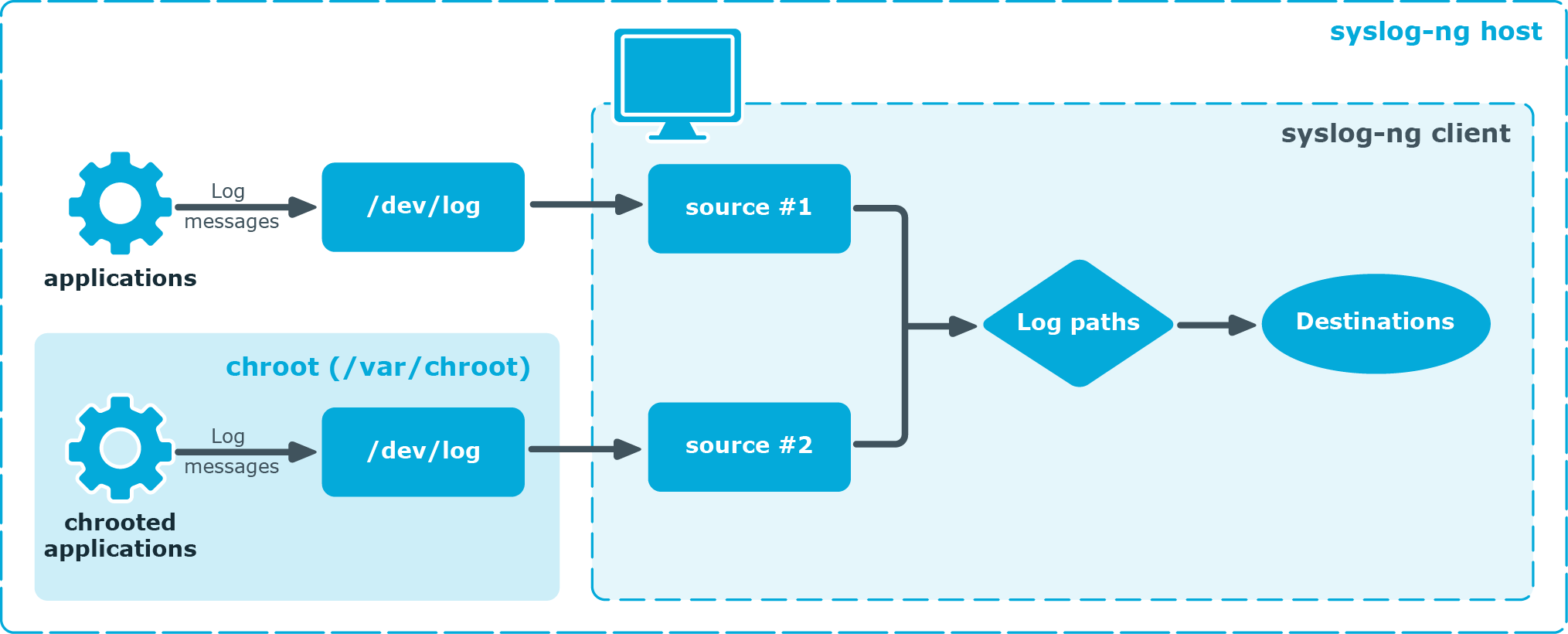Resolving hostnames locally
Purpose:
Resolving hostnames locally enables you to display hostnames in the log files for frequently used hosts, without having to rely on a DNS server. The known IP address – hostname pairs are stored locally in a file. In the log messages, syslog-ng will replace the IP addresses of known hosts with their hostnames. To configure local name resolution, complete the following steps:
Steps:
-
Add the hostnames and the respective IP addresses to the file used for local name resolution. On Linux and UNIX systems, this is the /etc/hosts file. Consult the documentation of your operating system for details.
-
Instruct syslog-ng to resolve hostnames locally. Set the use-dns() option of syslog-ng to persist_only.
-
Set the dns-cache-hosts() option to point to the file storing the hostnames.
options {
use-dns(persist_only);
dns-cache-hosts(/etc/hosts);
};
Collecting logs from chroot
Purpose:
To collect logs from a chroot using a syslog-ng client running on the host, complete the following steps:
Figure 22: Collecting logs from chroot

Steps:
-
Create a /dev directory within the chroot. The applications running in the chroot send their log messages here.
-
Create a local source in the configuration file of the syslog-ng application running outside the chroot. This source should point to the /dev/log file within the chroot (for example, to the /chroot/dev/log directory).
-
Include the source in a log statement.
NOTE: You need to set up timezone information within your chroot as well. This usually means creating a symlink to /etc/localtime.
Configuring log rotation
The syslog-ng OSE application does not rotate logs by itself. To use syslog-ng OSE for log rotation, consider the following approaches:
Use logrotate together with syslog-ng OSE:
-
It is ideal for workstations or when processing fewer logs.
-
It is included in most distributions by default.
-
Less scripting is required, only logrotate has to be configured correctly.
-
Requires frequent restart (syslog-ng OSE must be reloaded/restarted when the files are rotated). After rotating the log files, reload syslog-ng OSE using the syslog-ng-ctl reload command, or use another method to send a SIGHUP to syslog-ng OSE.
-
The statistics collected by syslog-ng OSE, and the correlation information gathered with Pattern Database, are lost with each restart.
Separate incoming logs based on time, host or other information:
-
It is ideal for central log servers, where regular restart of syslog-ng OSE is unfavorable.
-
Requires shell scripts or cron jobs to remove old logs.
-
It can be done by using macros in the destination name (in the filename, directory name, or the database table name). (For details on using macros, see Templates and macros.)
Example: File destination for log rotation
This sample file destination configuration stores incoming logs in files that are named based on the current year, month and day, and places these files in directories that are named based on the hostname:
destination d_sorted {
file(
"/var/log/remote/${HOST}/${YEAR}_${MONTH}_${DAY}.log"
create-dirs(yes)
);
};
Example: Command for cron for log rotation
This sample command for cron removes files older than two weeks from the /var/log/remote directory:
find /var/log/remote/ -daystart -mtime +14 -type f -exec rm {} \;
Load balancing logs between multiple destinations
These sections describe a method of load balancing logs between multiple syslog-ng Open Source Edition (syslog-ng OSE) destinations. The first subsection describes the round robin load balancing method based on the R_MSEC macro of syslog-ng OSE, while the second subsection describes a configuration generator that you can use as an alternative to using the example configuration described in the first subsection.
For more information about the R_MSEC macro and further macros of syslog-ng OSE, see Macros of syslog-ng OSE.
Topics:

